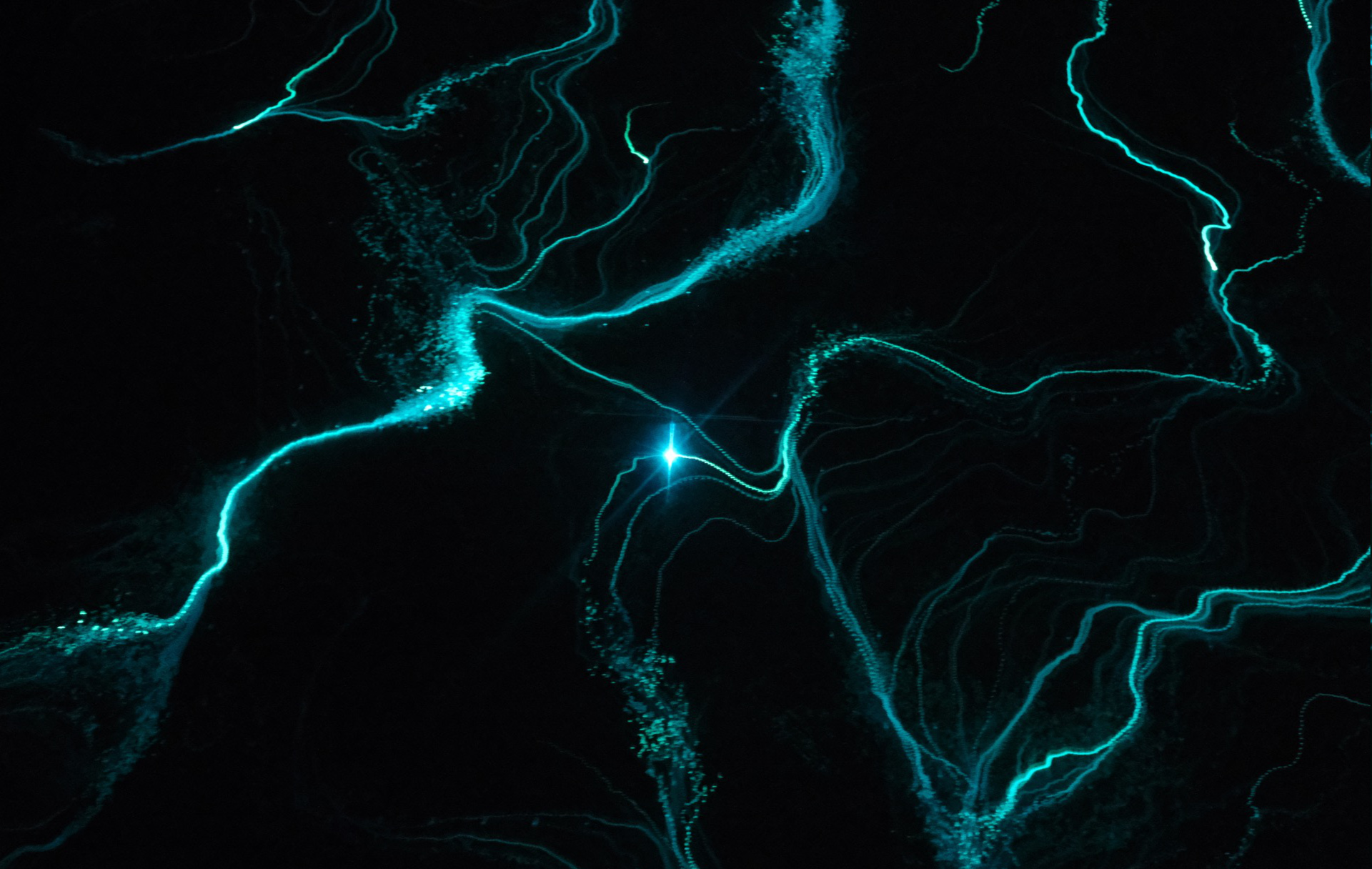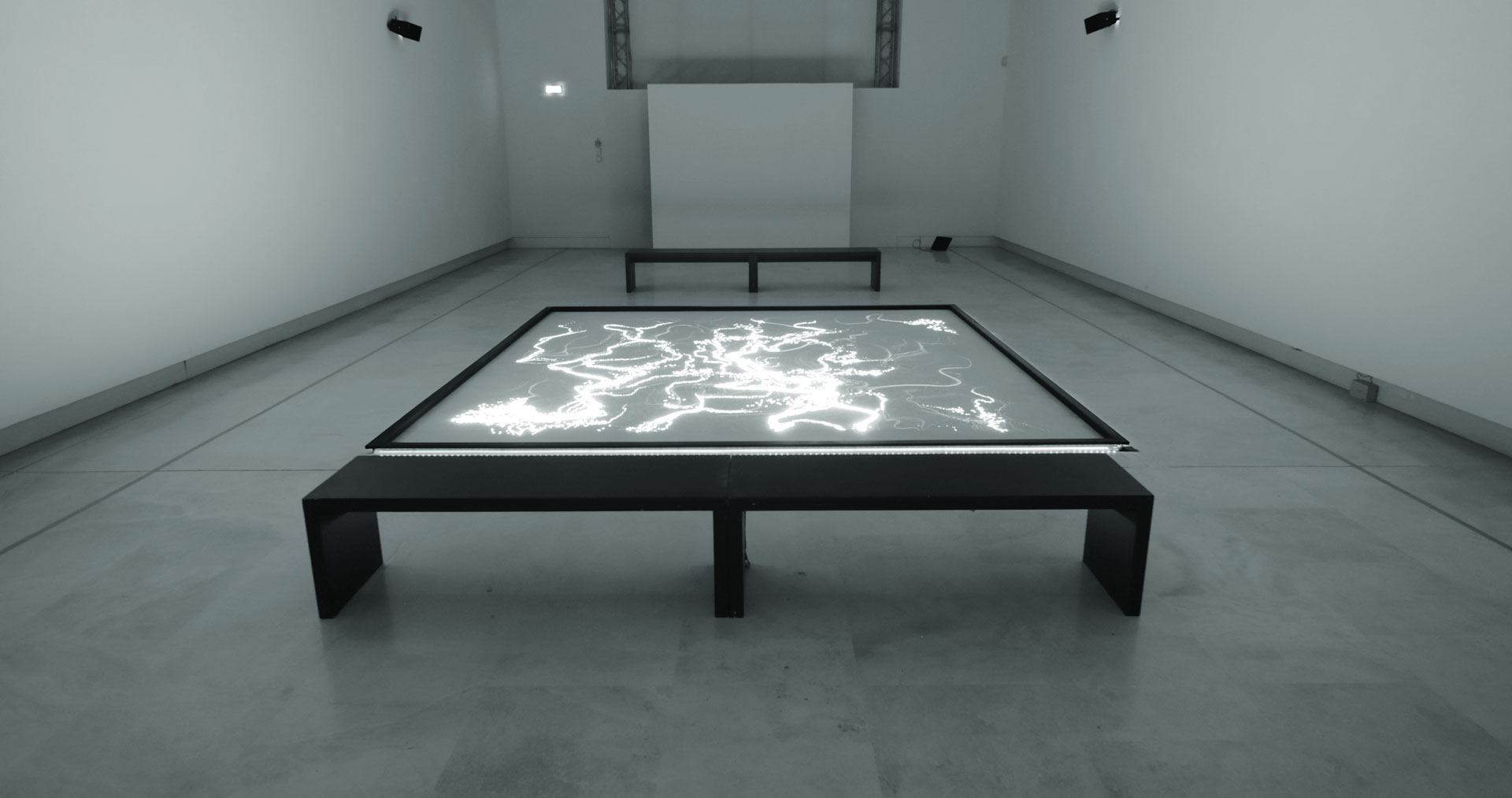Phosphor
UV laser installation [2017, modified 2018, 2021]

Focused rays of ultraviolet light paint temporary landscapes on a layer of phosphorous dust. Operating on concepts of erosion and mutation, the installation changes its behaviour and visual appearance over time: Each trace of light leaves a mark on a virtual mountain range, like water slowly washing out deep canyons, observed from above.
Memory
The light source which acts as the pen is a single laser beam, controlled by a computer and moving very fast. Our eyes are slow. If we were rotating that beam in a circle fast enough, we would see a continuous shape, which in reality is just a moving dot. But our memory is limited, we only merge visual data appearing in a very short period into a single shape, less than 1/20 of a second.
In this installation, the laser beam hits phosphorescent pigments, and those keep emitting light up to 30 minutes after being exposed, slowly getting darker over time.
The canvas keeps a memory of the movements of the laser beam for that time period, where the newest traces are brightest, and history slowly fades away. As a result, everything which has been drawn in the last half hour adds up to the image, creating a more complex, more intricate, but only temporary painting.
Landscape
At the hidden digital core of the installation, a piece of code represents an imaginary landscape, a 3D model of a non-existing world, a mountain range of data.
The laser beam draws the result of placing a drop of water onto a random position in this landscape and calculating the best path downwards the coast, which is the edges of the canvas.
Whilst doing so, it slightly changes the mountain's shape, in a very rough approximation of the effects of erosion, resulting in different trajectories throughout the passing of time.
Time, God, Flaws
The model is not perfect, it needs divine intervention to stay interesting. Sometimes the path of the virtual water drops is artificially shaken, turning the straight lines into a cloud of points, a little thunderstorm, which looks nice and speeds up the process of erosion.
At other times, the movements follow a grid, inspired by the large-scale man-made structures we planted in the landscape around us, like endless progressions of oil pumps in the desert.
The only thing pre-programmed is the basic behaviour and a set of random probabilities for certain events to happen. The process of creation: tuning those values, defining the speeds of movements, the amount of inherent randomness. Afterwards the world is left to its own, outside of control by the artist, who becomes observer, just like the audience.
Exhibitions

March 16th 2023 - June 4th 2023
London, England
Thin Air
November 4th 2021 - November 7th 2021
Namur, Belgium
KIKK festival
August 8th 2021 - August 15th 2021
Cluj, Romania
Electric Castle Festival
February 07 2020 - February 08 2020
Philharmonie Berlin Herrman Wolf Saal
Strom Festival
Berlin, Germany
October 23 2019 - October 27 2019
Theatro Circo
INDEX Festival
Braga, Portugal
August 20th 2019 - August 25th 2019
Montreal, Canada
SAT
MUTEK Festival
March 28 2019 - June 9 2019
Espacio Fundacion Telefonica
Lima, Peru
November 9th 2018 - November 20th 2018
Maubeuge, France
Festival VIA
September 19th 2018 - September 23rd 2018
Nantes, France
Château des ducs de Bretagne
Scopitone Festival 2018
October 7th 2017 - January 7th 2018
Rome, Italy
Palazzo delle Esposizioni
DigitaLife, Romaeuropa Festival 2017